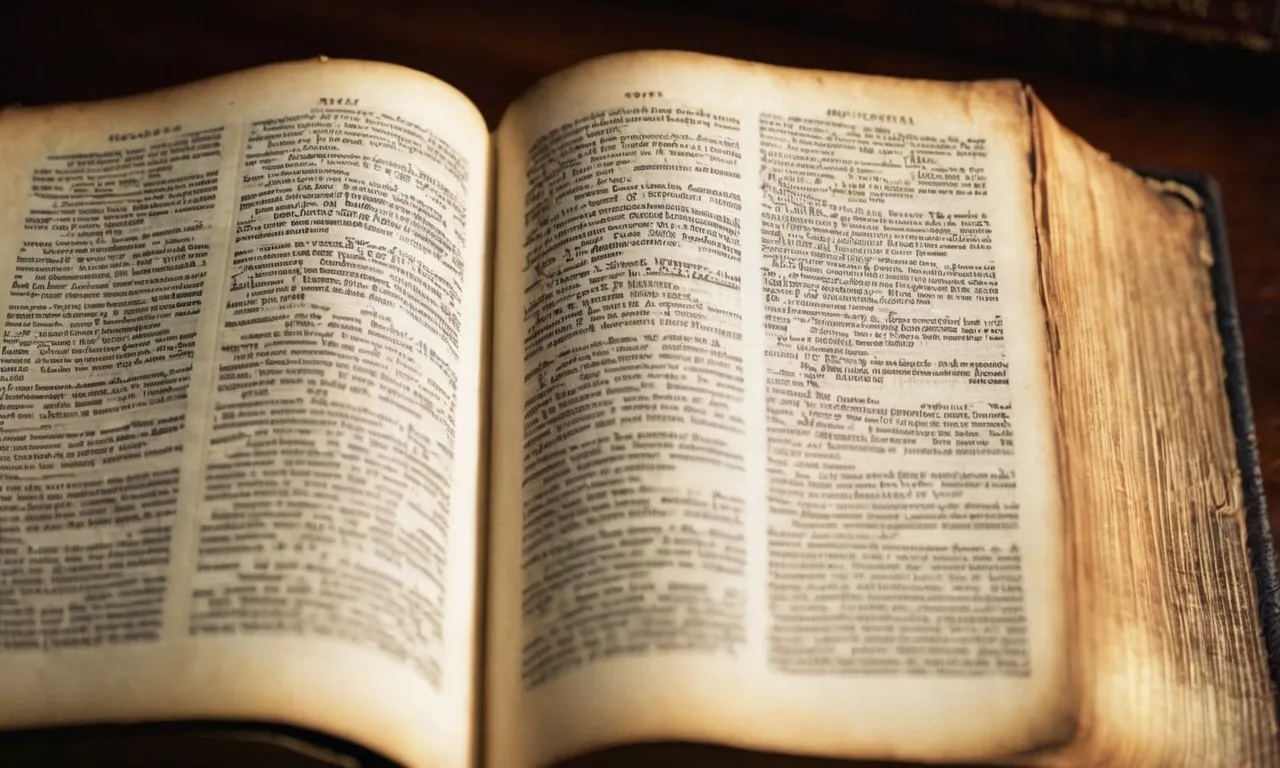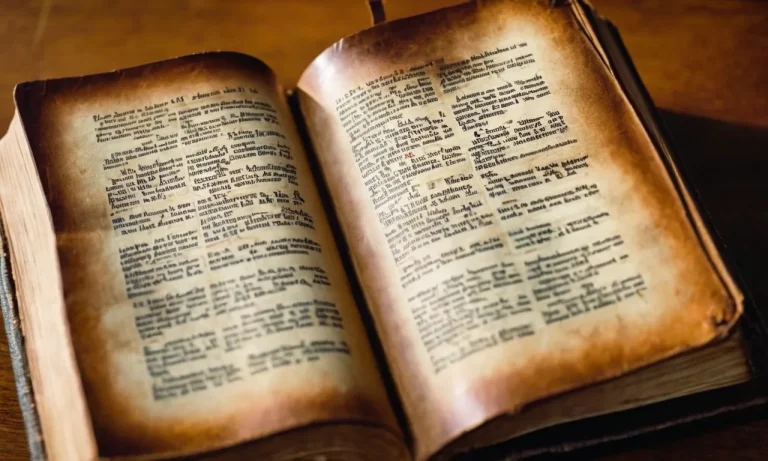What Is A Chronological Bible?
The Bible is the sacred text at the heart of Christianity and Judaism. It consists of 66 books written by over 40 authors over a span of 1500 years. With its complexity and size, reading the Bible from start to finish can be an intimidating task for many.
If you’re short on time, here’s a quick answer to your question: A chronological Bible rearranges the books of the Bible into an approximate chronological order to help readers understand the overarching narrative more clearly.
In this comprehensive guide, we’ll cover everything you need to know about chronological Bibles – from how they differ from traditional Bibles, the principles behind reorganizing the books chronologically, the most popular chronological arrangements, and the benefits and drawbacks of reading the Bible this way.
What is a Chronological Bible and How is it Different from a Traditional Bible
Basic Definition of a Chronological Bible
A chronological Bible arranges the books of the Bible in the order the events actually happened historically. Rather than having the books in the traditional order we find in most Bibles, the chronological Bible reorganizes them based on the timeline of when each story occurred.
This allows you to read through the Bible as the events unfolded in real time.
The key advantage of this type of Bible is that it helps you gain a clearer understanding of what was happening when – making it easier to follow along. By putting everything in chronological order, you can see connections between different stories and better grasp the historical context.
Key Differences from a Traditional Bible
There are several notable ways a chronological Bible differs from the traditional Bible format:
- Books are rearranged based on chronology rather than keeping them in the traditional order.
- Stories are woven together rather than being siloed by book. For example, the exodus story may integrate parts of Exodus, Leviticus, Numbers, and Deuteronomy rather than keeping each separate.
- Notes and commentary are included to help clarify the timeline and provide context.
- New introductions and divisions help highlight different periods of history.
- Repeated stories are only included once in chronological order.
The goal is to create one seamless narrative that flows in order of when events happened. This often results in a significantly different reading experience compared to a traditional Bible.
According to a 2021 survey by the Barna Group, nearly 1 in 5 Bible readers prefer a chronological format for their primary Bible. So while the traditional Bible order still dominates, chronological Bibles are gaining popularity as people seek to engage with Scripture in a fresh way.
Principles and Approaches Behind Arranging the Bible Chronologically
Seeking to Reveal the Overarching Narrative
One of the main principles behind creating a chronological Bible is to reveal the overarching narrative that runs through Scripture. When the books of the Bible are rearranged chronologically, it helps connect the dots and see God’s grand story unfold from beginning to end.
Readers can better trace the progression of God’s purposes and plans as He deals with mankind over the centuries. Key themes, prophecies, and theological concepts take on a clearer shape when viewed through a chronological lens.
No Universally Agreed Chronology
There is no one universally accepted chronological arrangement of the Bible’s books. Different scholars and publishers order the books slightly differently depending on the dating methods and assumptions they use.
For example, some may date Job earlier than others based on textual clues about its setting. So while the goal of chronological Bibles is the same, there can be variations in the final sequence.
Old Testament vs New Testament Ordering
Chronologically arranging the Old Testament is generally more straightforward than reordering the New Testament. The Old Testament books cover a longer time span and can be pegged to known historical eras and dates.
The New Testament books, however, cover only around 70 years, so dating and sequencing them is more complex and contested among scholars. For example, the placement of Galatians depends on when Paul’s visits to Jerusalem mentioned in it are identified.
Most Popular Chronological Arrangements of Bible Books
The Narrated Bible by F. LaGard Smith
The Narrated Bible by F. LaGard Smith is one of the most well-known chronological arrangements of the Bible. In this version, Smith aims to present the overarching narrative of the Bible in chronological order, from Genesis to Revelation.
He arranges the books into sixty-nine sections meant to be read as a continuous story. Smith’s goal is to help readers experience the Bible as a single grand narrative, rather than a collection of books.
This arrangement has been praised for making the Bible’s narrative more coherent and easier to follow.
The Chronological Study Bible (NKJV)
The Chronological Study Bible (NKJV) is another popular chronological arrangement published by Thomas Nelson. This study Bible rearranges the books of the Bible according to a chronological timeline. The New King James Version text is used.
Events from various books are interwoven into one storyline, allowing readers to follow the historical sequence from Genesis to Revelation. Study notes and full-color graphics provide historical and archaeological background information.
This study Bible helps readers gain clarity on the chronology of biblical events and see how they fit together into one grand narrative.
The Daily Bible in Chronological Order by F. LaGard Smith
The Daily Bible in Chronological Order by F. LaGard Smith is a unique chronological arrangement divided into daily readings. The entire Bible is arranged in chronological order and separated into 365 portions meant to be read in one year.
This allows readers to go through the entirety of Scripture in the chronological order the events occurred. The daily reading format helps readers regularly engage with the Bible’s narrative without getting bogged down.
Readers praise this chronological arrangement for making the overall biblical storyline easier to grasp when read in small sections over the course of a year.
The Books of Bible in Chronological Order by Yohanan Aharoni and Michael Avi-Yonah
The Books of Bible in Chronological Order by Yohanan Aharoni and Michael Avi-Yonah is a scholarly chronological arrangement published in 1999. This book contains the complete text of the Bible books rearranged into chronological order and divided into nine historical periods.
It aims to present the books in the sequence the events occurred according to modern scholarly understanding. Extensive commentary and notes are included explaining the reasoning behind the chronological ordering.
Though not as widely known, this chronological arrangement is valued for its academic approach based on up-to-date biblical scholarship.
The Benefits and Drawbacks of Reading the Bible Chronologically
Benefits of a Chronological Reading
Reading the Bible in chronological order can provide many benefits for understanding God’s unfolding plan of redemption. Here are some of the key advantages:
- Seeing the Bible’s historical narrative flow in sequence can help make sense of the overall storyline and interconnections between biblical events and people.
- Understanding the culture and context surrounding each book or passage becomes easier when reading chronologically.
- The prophetic writings align more meaningfully when paired with the historical events they reference.
- New Testament passages and theology build directly on the foundations established in the Old Testament.
- Reading the Psalms alongside the historical accounts they relate to brings them to life.
- Recurring themes, attributes of God, and patterns of human behavior start to emerge when Scripture is viewed as one continuous story.
Potential Drawbacks to Consider
Despite the benefits, there are also some potential downsides to reading the Bible in chronological sequence:
- The order of books varies from the traditional Biblical canon, which can be confusing at first.
- Flipping around between Old and New Testament books requires constant bookmarks and page turning.
- Seeing all books as part of the same linear timeline flattens the theological distinctives between genres.
- Readers may inject overly simplistic cause-and-effect assumptions between historical events.
- The practice of prooftexting and clipping verses out of context becomes tempting.
- The functionality of the Biblical canon in its final form may become under-appreciated.
To maximize chronological reading’s benefits while minimizing drawbacks, it helps to still keep each book’s original form and context in mind. Additionally, varying one’s reading approach instead of solely using a chronological lens can bring helpful perspectives.
Consulting study notes and resources to enhance understanding is also wise. With balance and discernment, a chronological reading plan can enrich many Bible students’ experience.
Tips for Getting the Most Out of a Chronological Bible
Use as a Supplement, Not a Replacement
A chronological Bible rearranges the order of biblical books and passages to present them in approximate chronological order. However, the canonical order of books in traditional Bibles also has value and meaning.
Using a chronological Bible as your sole Bible could cause you to miss important connections between books. Instead, read a chronological Bible as a supplement to give you a fresh perspective on Scripture.
Take Notes as You Read
As you read through a chronological Bible, jot down notes about new insights you gain or questions that arise. For example, you may better understand the miracles of Jesus when reading the Gospels woven together.
Or storylines that play out over various Old Testament books may click better in chronological order. Capture these aha moments in a journal to cement your learnings.
You can also use your chronological Bible to take more organized notes on biblical figures and eras. For example, trace Moses’ life sequentially rather than jumping between Exodus, Leviticus, Numbers and Deuteronomy. This big-picture view can aid your Bible study.
Look Up Context Around Rearranged Passages
Since passages are removed from their biblical book context in a chronological Bible, you may need to cross-reference a standard Bible at times. For important passages, take time to read the surrounding verses in a regular Bible for fuller meaning.
For example, reading John 3 in context enriches your understanding of being “born again.”
As another idea, use the notes or appendix in your chronological Bible to understand why the editors sequenced passages in a certain order. For example, they may explain why certain psalms are placed together during the exile era. This can affirm the chronology or prompt your own study.
Conclusion
While there is no universally established correct chronological order due to gaps in our knowledge of precise dating, reading the Bible chronologically can help readers grasp the overarching narrative more clearly.
Chronological Bibles should be viewed as a supplement to, not a replacement for, traditional Bible reading. With an understanding of their principles and limitations in mind, they can be a uniquely valuable tool for gaining a big-picture perspective on Scripture.







